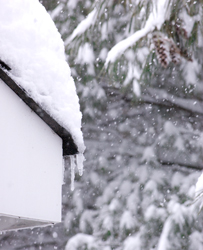
Outside
- Disconnect all hoses. If a hose is connected to an outdoor faucet and you get unexpected freezing, ice can form and pressure will build up in the water line inside your home. That’s when your water line can leak or even break.
- Insulated faucet jackets. Put an exterior insulated faucet jacket on your faucet to protect the connecting lines that run into your home from freezing temperatures.
- Drain the lines. Most homes have shut off valves located somewhere inside the home for the outside faucets. Draining your outside lines is very important. Not sure how or can’t find your shut off valves? Call us. It’s part of our winterizing services.
- Close vents and doors. Check to make sure that you’ve closed crawl space openings, including vents. Seal up cracks and openings around your crawl spaces, garage, or any other area that is large, mostly empty and unheated—especially if your water heater is in the garage or crawl space. Not doing some minimal insulating will make it work harder and eat up energy. That could be costing you a few hundred dollars every winter.
Inside
Inside your home, your biggest concerns are freezing pipes and conserving energy.
- Insulated water heater cover. Consider buying an insulated cover for your water heater, especially if it’s in an unheated area. Then, your water heater won’t have to work so hard to keep the water in the tank hot, which will reduce your energy bills.
- Leave cabinets open. If it’s very cold, leave cabinets that have pipes in them open, so the warmer air from the house can circulate around the pipes too.
- 55 degrees. Make sure that your home doesn’t fall below 55 degrees Fahrenheit—especially if you have vacation or rental properties that are vacant. Make sure to keep the utilities on to heat the dwelling. It’s better to pay a few utility bills than to have to clean up the mess that a burst pipe makes.
- Insulate your pipes. Insulate any pipes that may be exposed to freezing temperatures or wind—for example, pipes on an outside wall or in an unheated garage or crawl space.
- Run the water. If temperatures plummet and you’re very concerned about your pipes, let water trickle out of your faucet. Running water can’t freeze, so turn the water on just enough to create a stream that is about the width of a pencil.
An ounce of prevention really is worth a pound of the cure, as one of our clients found out a few winters ago. You can read her story in this blog from last winter and get more winter prep tips too.
Next time, we’ll tell you what to do if your pipes do actually freeze. In the meantime, get started on your prep work (so that you won’t even need the next blog), and if you need a hand, give us a call. We have a very thorough winterization service that will take the worry and the hassle out of getting ready for winter—especially if you have multiple locations that you’re responsible for.

